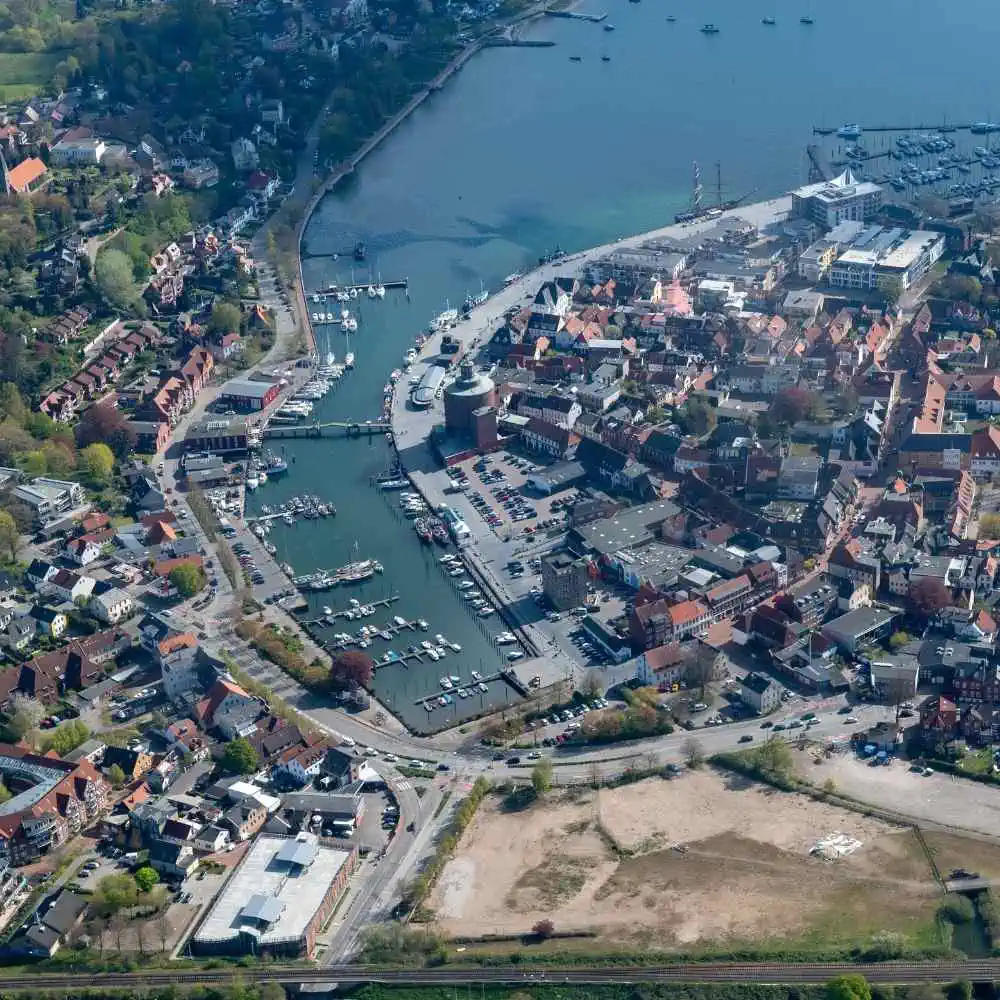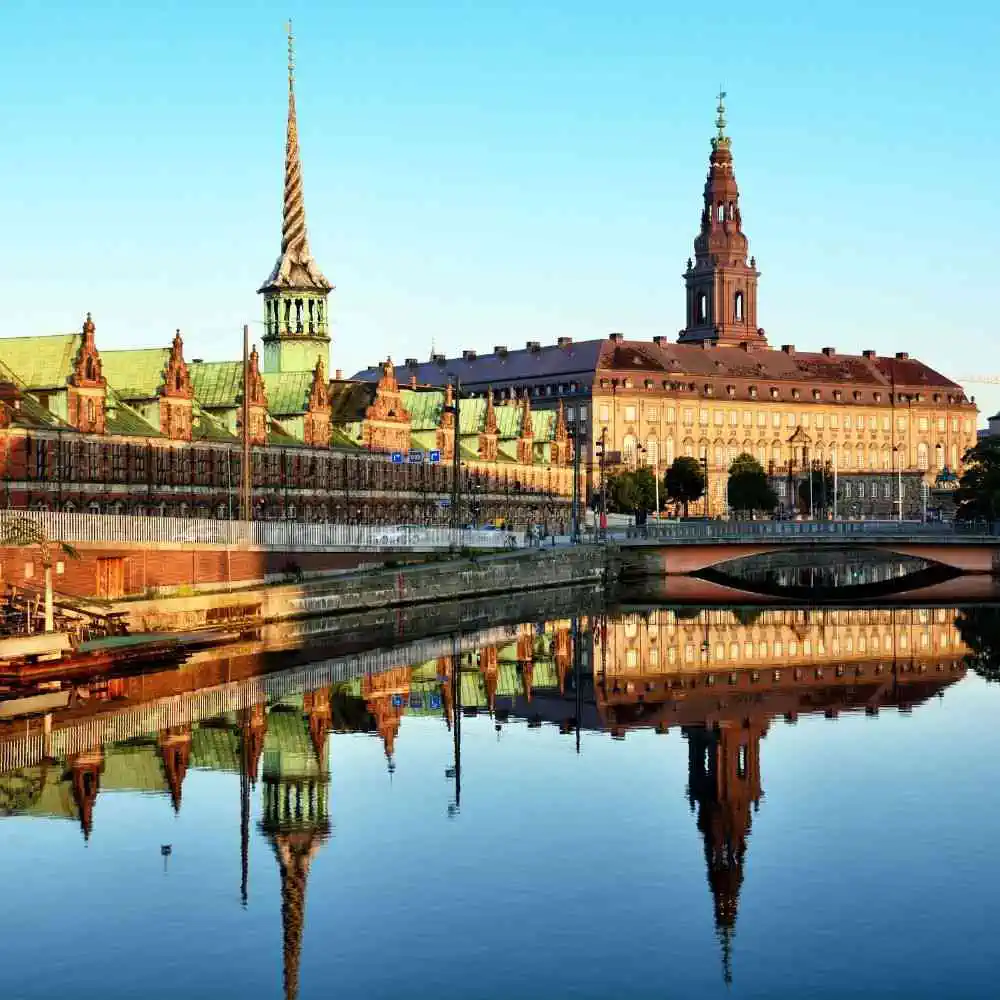Wyruszysz z Schleswig, położonego w samym centrum miasta Schleswig, i będziesz cieszyć się pięknymi widokami podczas podróży, aż dojdziesz do Kopenhaga, które również znajduje się w sercu Kopenhaga.
Pociągi z Schleswig do Kopenhagaod € 40.00
Pociągi z Schleswig do Kopenhaga
Podróżowanie pociągiem: Schleswig - Kopenhaga
For a memorable and comfortable journey, take a train ride from Schleswig, Germany to Copenhagen, Denmark! This route is both convenient and scenic, so you can sit back and take in the sights while you get from point A to point B. The total distance is 175 miles (281 kilometers) and the train takes about three hours and 45 minutes.
You'll pass through several populous cities, such as Hamburg, Lübeck, and Kiel in Germany, and Helsingør (Elsinore) in Denmark. All of these towns have interesting attractions, including old castles, palaces, and museums. Don't forget to look out for the stunning countryside, too!
Your journey will start at the Schleswig Station, where you'll get to admire the iconic redbrick facade that dates back to the year 1854. From there, you'll pass through Hamburg, the second largest city in Germany, and Lübeck, famous for its historical buildings and gothic churches. As you get closer to Copenhagen, you'll pass through Kiel, a beautiful seaside city, and Helsingør, home to the grand Kronborg Castle.
Finally, you'll arrive at Copenhagen Central Station, where you'll get to admire its majestic architecture and its many shops and eateries. Whether you're a history buff, a culture enthusiast, or a nature-lover, the Schleswig to Copenhagen route has something to offer for everyone.
So what are you waiting for? Book your tickets and embark on a memorable train ride from Schleswig to Copenhagen today!

Szczegóły podróży
How long does the train from Schleswig to Copenhagen take?
The journey from Schleswig to Copenhagen usually takes around 4 hours and 30 minutes to 5 hours, depending on the connection and the number of transfers.
What is the fastest journey from Schleswig to Copenhagen by train?
The fastest train journey from Schleswig to Copenhagen can take as little as 4 hours and 20 minutes with the right connections and minimal transfer time.
How much does the train cost from Schleswig to Copenhagen?
The cost of a train ticket from Schleswig to Copenhagen varies, but it typically starts from about €29 to €60, depending on the booking time and class.
How much does the Schleswig to Copenhagen?
No, there are no direct trains from Schleswig to Copenhagen. At least one transfer is usually required, often in Hamburg or Flensburg.
What is the distance from Schleswig to Copenhagen by train?
The distance from Schleswig to Copenhagen by train is approximately 330 Km.
Which are the cities that the train stops from Schleswig to Copenhagen?
The train from Schleswig to Copenhagen typically stops in key cities such as Flensburg, Hamburg, and Odense, among others, depending on the route and the service provider.
Schleswig: Miejsca do zobaczenia
Schleswig is a charming German city located near the border of Denmark. It is known for its rich history and culture, as well as its stunning architecture. Schleswig is a great place to visit if you’re looking to explore the past and appreciate a variety of natural beauty. Here are some of the key places of interest and delicious food for you to experience during your trip to Schleswig.
Schleswig Town Hall: Schleswig Town Hall is a historic building located in the city center. It was built in the 16th century and is considered one of the best preserved city halls in Germany. The building is open to visitors every day, and entrance is free of charge. Insider tip: take a guided tour of the building to hear interesting stories about the town and its history.
Kremper Tor: Kremper Tor is an old city gate located on the east side of the city, dating back to the Middle Ages. It was used to protect the city and is a great place to visit to learn about the city's past. Entrance is free and it is open from 10am to 5pm. Insider tip: take a walk around the surrounding area and enjoy the views of the ancient city walls and towers.
Rote Strasse: Rote Strasse is the main shopping street in Schleswig. It is filled with shops, restaurants, cafes and bars. It is a great place to explore and find souvenirs to bring home from your trip. Insider tip: visit the many street food stalls to try traditional German dishes like bratwurst and schnitzel.
St. Petri Kirche: St. Petri Kirche is a beautiful church located in the heart of the city. The church was built in the 13th century and is one of the oldest churches in Schleswig. Entrance is free and it is open from 10am to 5pm. Insider tip: if you visit during the summer months, attend one of the classical music concerts that are held in the church.
Solitüder Park: Solitüder Park is a beautiful park located in the north of Schleswig. It is a great place to explore and admire the nature of the city. Entrance is free and the park is open from sunrise to sunset. Insider tip: visit in the morning to get the best views of the lake and the surrounding area.
Schleswig Museum: The Schleswig Museum is a great place to learn about the history and culture of the city. It is filled with exhibits and artifacts that tell the story of the city. Entrance is free and the museum is open from 10am to 6pm. Insider tip: visit the museum courtyard to see the old windmill.
St. Nikolai Church: St. Nikolai Church is one of the most impressive churches in Schleswig. It is located in the old town and was built in the 12th century. Entrance is free and the church is open from 10am to 4pm. Insider tip: attend one of the daily services held by the church to experience the incredible atmosphere inside.
Schleswig is an amazing city full of history and beauty. Whether you’re looking to explore the city’s past, enjoy its natural scenery, or simply relax and take in the local culture, there is something for everyone to enjoy in Schleswig. With so much to see and do, you’re guaranteed a memorable experience in this wonderful city.

Kopenhaga: Miejsca do zobaczenia
Kopenhaga, stolica Danii, to miasto, które zachwyca na każdym kroku. Od historycznych zabytków, przez awangardową architekturę, aż po światowej klasy kuchnię - Kopenhaga oferuje niezliczone atrakcje, które sprawiają, że jest to miejsce wyjątkowe. Oto lista siedmiu kluczowych miejsc, które każdy odwiedzający powinien zobaczyć, aby w pełni doświadczyć ducha tego miasta.
Zamek Rosenborg
Historia i architektura mieszają się w Zamku Rosenborg, dawnej rezydencji królewskiej, która teraz przechowuje skarby narodowe i klejnoty koronne.
Lokalizacja: centrum Kopenhagi.
Godziny otwarcia: 10:00-16:00, zmienne w zależności od sezonu.
Opłata za wstęp: około 16 €.
Wskazówka: Nie przegap okazji, aby zobaczyć ogrody zamkowe, które są otwarte dla publiczności bezpłatnie.
Nyhavn
Malowniczy kanał Nyhavn z jego kolorowymi kamienicami z XVII i XVIII wieku to jedno z najbardziej fotografowanych miejsc w Kopenhadze.
Lokalizacja: w sercu miasta.
Godziny otwarcia: dostępny przez cały rok.
Opłata za wstęp: brak.
Wskazówka: Idealne miejsce, aby spróbować świeżych ryb i owoców morza w jednej z licznych restauracji.
Pałac Amalienborg
Dom duńskiej rodziny królewskiej oferuje unikalny wgląd w życie monarchii.
Lokalizacja: niedaleko portu.
Godziny otwarcia: 10:00-17:00.
Opłata za wstęp: około 12 €.
Wskazówka: O godzinie 12:00 można oglądać zmianę warty.
Mała Syrenka
Symbol Kopenhagi, statua Małej Syrenki, inspirowana baśnią Hansa Christiana Andersena, jest must-see dla każdego turysty.
Lokalizacja: na brzegu portu.
Godziny otwarcia: dostępna przez cały rok.
Opłata za wstęp: brak.
Wskazówka: Wybierz się tam wcześnie rano, aby uniknąć tłumów.
Christiansborg
Pałac Christiansborg, na wyspie Slotsholmen, to siedziba duńskiego parlamentu, Sądu Najwyższego oraz urzędu premiera.
Lokalizacja: centrum miasta.
Godziny otwarcia: 10:00-17:00.
Opłata za wstęp: około 20 € za pełny dostęp.
Wskazówka: Nie przegap wnętrz pałacowych, które zachwycają bogactwem i detalami.
Tivoli
Jedne z najstarszych działających ogrodów rozrywki na świecie, oferują nie tylko atrakcje, ale także koncerty i spektakle.
Lokalizacja: blisko centrum.
Godziny otwarcia: różne, w zależności od sezonu.
Opłata za wstęp: około 18 €.
Wskazówka: Odwiedź wieczorem, aby doświadczyć magicznej atmosfery oświetlonego parku.
Narodowe Muzeum Danii
To miejsce, gdzie można zgłębić historię Danii i całej Skandynawii.
Lokalizacja: w centrum Kopenhagi.
Godziny otwarcia: 10:00-17:00.
Opłata za wstęp: bezpłatne dla wielu ekspozycji.
Wskazówka: Idealne dla miłośników historii i kultury.
Podsumowanie: Kopenhaga oferuje niezliczone możliwości odkrywania, od zabytków po kuchnię. Poruszanie się po mieście jest łatwe dzięki rozbudowanej sieci transportu publicznego, w tym rowerów miejskich, które są świetną opcją, aby poczuć klimat miasta jak lokalny mieszkaniec. Niezapomniana przygoda gwarantowana!

Schleswig: Główne stacje kolejowe
The main train station of Schleswig in Germany, The Schleswig Central Train Station, is located in the center of the city and is a very important station for the transportation of tourists and locals. There are also other smaller train stations in Schleswig where passengers can change trains and get to their destination.
The Schleswig central train station has been renovated recently and it serves many destinations both in Germany and other countries. It has a modern infrastructure with a waiting room, ticket office, luggage storage, toilets, and ATM. The address is Schleswiger Str. 17-19, 24837 Schleswig, and its opening hours are from 5 AM to 12 PM. The telephone number is 0431-206661 and visitors can store their luggage in lockers for a small fee.
- Schleswig
Kopenhaga: Główne stacje kolejowe
Podczas wizyty w tętniącym życiem mieście Kopenhaga, Dania, centralnym punktem dla podróżnych jest niewątpliwie Centralny Dworzec Kopenhagi (Københavns Hovedbanegård). Ta kluczowa stacja to nie tylko największa stacja w Danii, ale również ważny węzeł komunikacyjny dla podróży międzynarodowych i krajowych. Choć Centralny Dworzec Kopenhagi przyciąga najwięcej uwagi, warto zauważyć, że miasto posiada również kilka innych znaczących stacji takich jak Nørreport i Østerport, obsługujących różne części miasta i jego przedmieścia.
Obecność wielu stacji podkreśla dobrze rozwiniętą sieć kolejową Kopenhagi, zapewniającą bezproblemową łączność zarówno turystom, jak i mieszkańcom.
Centralny Dworzec Kopenhagi jest strategicznie położony przy Bernstorffsgade 16, w samym sercu miasta, co sprawia, że jest łatwo dostępny z różnych punktów zainteresowania. Godziny pracy zazwyczaj rozpoczynają się wcześnie rano i trwają do późnej nocy, choć zaleca się sprawdzenie konkretnych czasów, ponieważ mogą one się różnić. Dla podróżnych z ciężkim bagażem, stacja oferuje wygodne usługi przechowywania bagażu, pozwalając na swobodne zwiedzanie miasta bez konieczności noszenia ze sobą rzeczy. Takie udogodnienia poprawiają ogólne doświadczenie podróżne, czyniąc Centralny Dworzec Kopenhagi idealnym punktem wyjścia do każdej podróży po mieście czy dalej.
- Kopenhaga
- Buddinge St.
- Gentofte St.
- Enghave St.
- Stengården St.
Schleswig - Kopenhaga: Jak uzyskać najlepsze oferty
Rezerwuj z wyprzedzeniem:
Tak jak w przypadku cen biletów lotniczych, ceny biletów kolejowych mają tendencję do wzrostu, gdy data odjazdu zbliża się. Rezerwacja tygodni lub nawet miesięcy z wyprzedzeniem może przynieść znaczne oszczędności.
Podróżuj poza godzinami szczytu:
Unikaj podróżowania w godzinach szczytu, takich jak poranki i wieczory w dni robocze. Wybierz południe, późny wieczór lub środek tygodnia, gdy popyt jest mniejszy.
Rozważ wolniejsze pociągi lub trasy pośrednie:
Pociągi ekspresowe lub szybkie mogą zaoszczędzić czas, ale często są droższe. Wybór regionalnych lub wolniejszych usług może zmniejszyć koszt biletu.
Szukaj specjalnych ofert i promocji:
Przewoźnicy kolejowi od czasu do czasu oferują promocje lub specjalne okazje, szczególnie poza sezonem szczytowym. Warto zapisać się na newslettery. Ponadto czasami dostępne są zniżki dla grup lub na bilety powrotne, więc rozważ te opcje, jeśli pasują do Twoich planów podróży.
Wszystko, co musisz wiedzieć
Potrzebujesz pomocy?
Gwarantowana bezpieczna płatność
Certyfikaty


